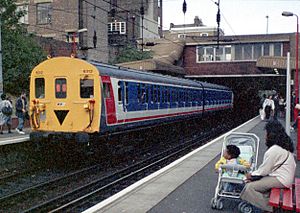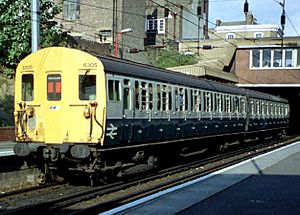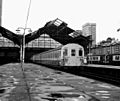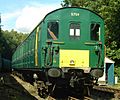British Rail Class 416 facts for kids
Quick facts for kids British Rail Class 416 |
|
|---|---|

Class 416 train in Network SouthEast livery calls at Dalston Kingsland Station, on a North London Line working. The NLL is both 25 kV overhead AC and 750 V third-rail DC electrified at this point.
|
|
| In service | 1956-1995 |
| Manufacturer | Ashford Works, Eastleigh works & Lancing works |
| Formation | DMBS-DTS or DMBS-DTC |
| Operator(s) | British Rail |
| Specifications | |
| Car length | 19.50m |
| Maximum speed | 75mph 121 km/h |
| Weight | DMBS 40 tons DTS 30 tons DTC 30 tons |
| Power output | 2 x 250 hp traction motors total 500 hp (373 kW) |
| Electric system(s) | 660-750V dc third rail |
| Track gauge | standard gauge |
The British Rail Class 416 trains were a special type of electric multiple unit (EMU). An EMU is a train made of several carriages that can run on its own, powered by electricity. These trains were also known as 2EPB trains. They were built between 1953 and 1956. Their main job was to carry passengers on short trips around London. They ran on the busy Southern Electric network.
Contents
Meet the Class 416 Trains
The Class 416 trains were designed for busy suburban routes. This means they carried people living in the areas just outside London into the city. They were a common sight on the railway lines in the south of England for many years.
What is an Electric Multiple Unit?
An electric multiple unit, or EMU, is a type of train that gets its power from electricity. Unlike trains pulled by a separate locomotive, an EMU has its motors and power equipment built into its passenger carriages. This allows the train to be more flexible. It can be easily joined together or separated into different lengths. The Class 416 trains usually ran in two-carriage sets.
Where Did They Run?
These trains were mostly used on the Southern Electric network. This is a large network of railway lines in the south of England that uses electricity to power its trains. They also ran on the North London line, which connects different parts of London. The Class 416 trains helped many people get to work or school every day.
How Were They Powered?
The Class 416 trains got their electricity from a "third rail." This is an extra rail laid next to the main tracks. It carries electricity at 660-750 volts of direct current (DC). A special shoe on the train touches this rail to pick up the power. This power then runs the train's motors. Each train had two powerful 250 horsepower motors. This gave them a total of 500 horsepower.
Life of the Class 416 Trains
The Class 416 trains started carrying passengers in 1956. They served the public for a long time, nearly 40 years! They were finally retired from service in 1995. Over their lifetime, they wore different paint schemes, or "liveries." These included the classic British Railways green, blue and grey, and the bright red, white, and blue of Network SouthEast. They could reach a top speed of 75 miles per hour (121 km/h).
Images for kids





